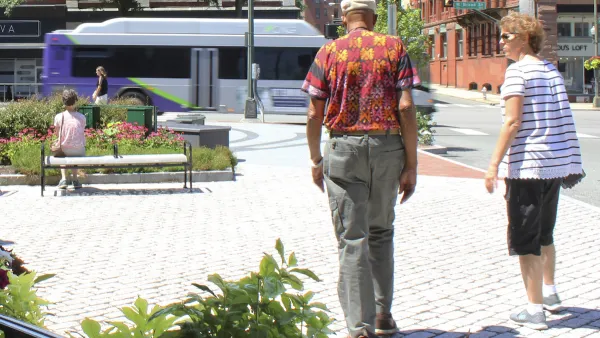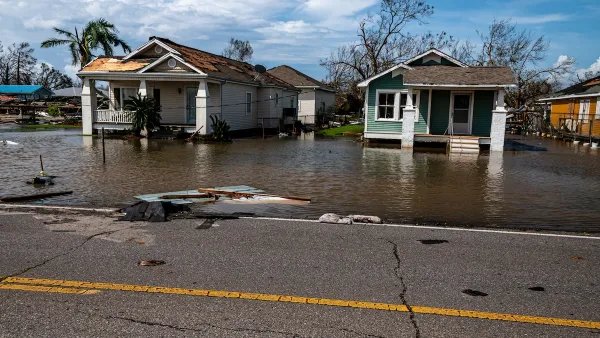Vacant properties are considered blight instead of potential, argues John Kromer of the Fels Institute. By acting strategically and thinking smaller, officials can revitalize their cities and attract new, more stable investment.
Up until the final years of the last century, most municipal development agencies didn't regard planning for the reuse of vacant and abandoned properties as a strategic priority. Prior to that time, the prevailing public-sector view had been dismissive: we don't own most of the vacant properties, and we don't have enough subsidy funding to get them developed-so what can we do, other than ask the code enforcement department to board up the most deteriorated buildings and clean up the most littered lots?
Thanks to the advocacy of organizations such as the National Vacant Properties Campaign, this view of vacant property as little more than a public-nuisance challenge has all but disappeared. We are now encouraged to regard vacant buildings and lots as economic assets that, under the right circumstances, can generate substantial added value to their downtown and neighborhood locations.
Although this change of perspective is welcome, it's not always easy to identify the particular "right circumstances" under which those vacant properties that offer the best prospects for success in the real estate market can be positioned for acquisition and development. Even if the economic condition of disinvested urban areas begins to improve sooner than expected, the chances are that many of the vacant properties that can be found in these places will remain vacant indefinitely. Given this state of affairs, how can we tell which ones are most likely to succeed?
Recent property transactions and development activity involving vacant buildings and lots in the neighboring cities of Philadelphia and Camden illustrate ways in which the potential value of some vacant properties can be realized. Although Philadelphia and Camden were not as hard hit by the foreclosure crisis as other cities, no one would have characterized these cities' real estate markets as particularly robust during the period in which most of these activities took place. This experience suggests that development opportunities can emerge in an economic environment that is far less than ideal.
The Philadelphia and Camden models can be grouped into four categories:
Small Parcel Transactions
In some relatively stable communities, individual vacant buildings and small vacant lots have proliferated on blocks that are otherwise fully occupied or relatively stable. To test the market for these small parcels, Philadelphia's Redevelopment Authority offered 22 of them for sale during a 90-day period earlier this year. Within three months, it was reported that nearly half of the addresses were under contract or had offers pending, totaling $560,000 in sales.
Infill Site Development
A particular kind of niche development has proven to be profitable in some urban neighborhoods: building well-designed, high-quality housing on medium-sized vacant sites (a half-acre or less, on residential or mixed-use blocks) in communities located in or near emerging or strong real estate markets. In 2008, Onion Flats, a Philadelphia design/build firm, completed and successfully marketed the nine-unit Thin Flats, the first LEED-H Platinum multi-family residence in Pennsylvania) on a cleared parcel in the city's Northern Liberties neighborhood.
In Camden during the same year, Pennrose Properties finished the first phase of Cooper Grant Homes, a 28-unit townhouse venture built on a former barrel-factory site near the Rutgers University campus. The eighteen units in this initial phase of the venture sold out within two weeks, with eleven of the homes sold on day one. Cooper Grant Homes is the first market-rate sales housing to be completed in Camden in a quarter-century.
Anchor Institutions
Urban academic and health care institutions have become increasingly active in stimulating investment and development in off-campus neighborhoods, often at vacant or neglected sites. Many recent institutional initiatives were influenced by the success of an ambitious investment program undertaken by the University of Pennsylvania during the late 1990s, which produced new housing and retail development, as well as an outstanding new public school, within a few blocks of campus. A new bookstore, hotel, and supermarket, now bustling with activity, were developed on unsightly surface parking lots.
A comparable institutional initiative is now taking place in Camden, where competing developers recently submitted proposals for the construction of a privately owned, 350-bed dorm for Rutgers graduate students on a half-block vacant parcel across the street from the campus. With University enrollment increasing from 6,000 to a projected 7,500 students, on-campus dorms are currently over capacity, with some students living in converted common-area space. The new development will include retail stores and parking.
Urban Agriculture
Greensgrow Farms, an urban farm located in Kensington, a Philadelphia row-house neighborhood, has expanded its operations onto an adjacent 4,000 square-foot vacant lot where five small houses once stood. On this site, Greensgrow now raises beans, manages a biodiesel operation (waste oils from neighborhood restaurants fuel the farm's truck) and worm composting, with plans for the development of a small childrens' garden well under way. Unlike many other urban agriculture ventures, Greensgrow's raised-bed farm and nursery, established on a 36,000 square foot former Superfund site in 1998, is a profitable business. Although a significant number of urban agriculture ventures currently rely on volunteer labor or operating subsidies, the combined influence of rising fuel prices and fast-growing consumer interest in locally grown produce suggest that more urban farms can achieve profitability in the future.
Most of the activities described above were implemented with reference to three principles that anyone interested in pursuing vacant property reclamation activities should bear in mind:
- Know your inventory. Organizing and maintaining a data base of vacant buildings and lots within a municipality, neighborhood, or target area is a critical first step in managing these potentially valuable assets.
- Act strategically. Decisions about which vacant properties are most marketable for reuses that strengthen the local economy and improve the surrounding environment should be based on a well-thought-out downtown or neighborhood investment strategy that has been designed in close coordination with business and community constituencies.
- Think smaller. A high degree of success can be achieved through the completion of many real estate investment and development transactions involving small- and medium-sized parcels, which, in the aggregate, will generate substantial economic benefit.
John Kromer, Senior Consultant at the Fels Institute of Government, is the author of Fixing Broken Cities: The Implementation of Urban Development Strategies.

Planetizen Federal Action Tracker
A weekly monitor of how Trump’s orders and actions are impacting planners and planning in America.

Vehicle-related Deaths Drop 29% in Richmond, VA
The seventh year of the city's Vision Zero strategy also cut the number of people killed in alcohol-related crashes by half.

As Trump Phases Out FEMA, Is It Time to Flee the Floodplains?
With less federal funding available for disaster relief efforts, the need to relocate at-risk communities is more urgent than ever.

More Apartments Are Being Built in Less-Dense Areas
Rising housing costs in urban cores and a demand for rental housing is driving more multifamily development to exurbs and small metros.

Plastic Bag Bans Actually Worked
U.S. coastal areas with plastic bag bans or fees saw significant reductions in plastic bag pollution — but plastic waste as a whole is growing.

Improving Indoor Air Quality, One Block at a Time
A movement to switch to electric appliances at the neighborhood scale is taking off in California.
Urban Design for Planners 1: Software Tools
This six-course series explores essential urban design concepts using open source software and equips planners with the tools they need to participate fully in the urban design process.
Planning for Universal Design
Learn the tools for implementing Universal Design in planning regulations.
Borough of Carlisle
Smith Gee Studio
City of Camden Redevelopment Agency
City of Astoria
Transportation Research & Education Center (TREC) at Portland State University
Camden Redevelopment Agency
City of Claremont
Municipality of Princeton (NJ)





























